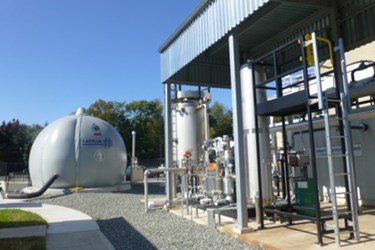Waste To Energy: WWTP Powered 100% By Renewable Sources

By Laura Martin

A wastewater treatment facility in New Jersey has gone off the grid.
Using an anaerobic digester and solar installations, the Village of Ridgewood Wastewater Treatment Plant is now producing enough renewable energy to completely power its facility on an annual basis.
“Anaerobic digestion has been around for 30 years, but it is just now starting to pick up speed in the United States. It has been done in a limited sense in other parts of the world, but not to this scale,” says Dennis Doll, president and CEO of the Middlesex Water Company, which is part of a 20-year partnership between the Village of Ridgewood, Natural Systems Utilities, and American Refining and Biochemical to manage the renewable energy project.
The digester captures methane from wastewater solids and converts it into electricity that is used to power the treatment plant and the anaerobic digester. The process has multiple benefits. The digester utilizes waste that would normally be trucked away and methane gas that would otherwise be released into the atmosphere.
“It is a missed opportunity for energy,” Doll says.
Food waste such as fats, oils, and grease (FOG) are also utilized as an energy source with the help of the digester. The plant is paid by industrial sites and restaurants to take certain types of FOG, which aren’t permitted to be disposed in the sewer system.
“They are hauling these materials as far away as Pennsylvania, so it costs them less to bring it to us,” says Doll. “These are 7,000 gallon tanker trucks, so in addition to making money we are also reducing the carbon footprint.”
The remainder of the energy required for the plant is produced by four solar generation facilities, which were constructed on several properties throughout the community.
The plant does have to occasionally purchase electricity to jumpstart their energy-creation process. But whatever energy they purchase, they must create and put back into the grid as soon as possible. To be considered a 100% renewable energy facility they must not use more electricity than they create on an annual basis.
Utilizing multiple methods to produce renewable energy is not only beneficial to the environment, but to the treatment plant’s bottom line. “Now that municipal budgets are getting tighter, everyone is looking for a way to stretch every dollar,” Doll says.
By creating its own energy, the plant is saving a significant amount of money each year, says Doll, although an exact number has not been determined. In addition to cost savings, the plant generates income by collecting the FOG and by selling its renewable energy certificates (RECs). These RECs represent the property rights to the environmental, social, and other nonpower qualities of renewable electricity generation and can be bought and sold between organizations.
These cost benefits are passed down to utility customers. “To the extent that the utility save money, they can pass the savings around to the users of the utility or supplement other municipal programs, and the community will see the savings somewhere else,” Doll says.
The public-private partnership means that the municipality bears no financial risk in taking on the project, Doll says.
Utilities across the county have reached out to the companies involved with the Ridgewood plant to create similar systems at their sites. There are currently two proposals being considered in other areas of New Jersey. The government of Columbia is even looking into similar applications.
“It is already getting more attention, Doll says. “The whole world is watching this.”
